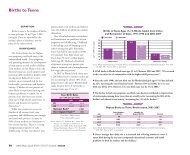2010 Rhode Island Kids Count Factbook
2010 Rhode Island Kids Count Factbook
2010 Rhode Island Kids Count Factbook
You also want an ePaper? Increase the reach of your titles
YUMPU automatically turns print PDFs into web optimized ePapers that Google loves.
Children’s Mental Health<br />
References<br />
Psychiatric Hospitals<br />
Children Under Age 19 Treated at <strong>Rhode</strong> <strong>Island</strong> Psychiatric Hospitals,<br />
October 1, 2008 – September 30, 2009<br />
Bradley Hospital Bradley Hospital Butler Hospital Butler Hospital<br />
General Psychiatric Developmental General Psychiatric Child Intensive<br />
Services Disabilities Program Services Services Unit<br />
Average Average Average Average<br />
# Length # Length # Length # Length<br />
Treated of Stay Treated of Stay Treated of Stay Treated of Stay<br />
Inpatient 1,135 11 days 129 46 days 485 11 days 97 25 days<br />
Residential 62 136 days 77 289 days – – – – – – – –<br />
Partial<br />
Hospitalization 515 11 days 37 12 days 83 5 days – – – –<br />
Outpatient 2,103 4 visits 87 4 visits 102 NA – – – –<br />
Source: Lifespan, <strong>2010</strong> and Butler Hospital, 2009. Programs can have overlapping enrollment. Number treated is based<br />
on the hospital census (i.e., the number of patients seen in any program during FY 2009). The average length of stay<br />
is based on discharges.<br />
-- = Service not offered. NA=Data not available for this service.<br />
◆ The two hospitals in <strong>Rhode</strong> <strong>Island</strong> that specialize in providing psychiatric care to<br />
children and youth are Bradley Hospital and Butler Hospital.<br />
◆ Inpatient treatment at a psychiatric hospital is the most intensive type of behavioral<br />
health care. In 2009, 1,846 children and youth received inpatient psychiatric treatment<br />
at either Bradley Hospital or Butler Hospital. At Bradley Hospital, the most common<br />
diagnoses for young people treated in an inpatient setting were bipolar disorders (39%),<br />
depressive disorders (24%), anxiety disorders (18%), and adjustment disorders (14%).<br />
At Butler Hospital the most common disorders were bipolar disorders (45%), depressive<br />
disorders (35%), anxiety disorders (7%), and child/adolescent disorders (6%). 23,24<br />
◆ Bradley Hospital has a Developmental Disabilities Program that offers highly specialized<br />
clinical services to children and adolescents who show signs of serious emotional and<br />
behavioral problems in addition to developmental disabilities. Bradley also operates four<br />
schools for children with behavioral health problems and developmental disabilities, which<br />
together had an average daily enrollment of 237 students in 2009. 25<br />
1,5,7<br />
Mental health: A report of the Surgeon General. (1999).<br />
Washington, DC: U.S. Department of Health and<br />
Human Services, Office of the Surgeon General.<br />
2<br />
Kim, H. K., Viner-Brown, S. I. & Garcia, J. (2007).<br />
Children’s mental health and family functioning in<br />
<strong>Rhode</strong> <strong>Island</strong>. Pediatrics, 119, S22-S28.<br />
(continued on page 165)<br />
<strong>Rhode</strong> <strong>Island</strong>’s Community Mental Health Centers<br />
◆ The seven Community Mental Health Centers (CMHCs) in <strong>Rhode</strong> <strong>Island</strong> are the<br />
primary source of public mental health treatment services available in the state for children<br />
and adults. During 2009, 7,929 children under age 18 were treated at community mental<br />
health centers, and 4,109 children were receiving services as of December 31, 2009. 26<br />
◆ Among the children who received services through <strong>Rhode</strong> <strong>Island</strong> CMHCs in 2009,<br />
20% presented with a primary diagnosis of attention deficit disorders, 17% with<br />
depressive disorders, 12% with conduct disorders and 12% with anxiety disorders. 27<br />
Child and Adolescent Intensive Treatment Services (CAITS)<br />
◆ The CAITS program, which is administered by the <strong>Rhode</strong> <strong>Island</strong> Department of Human<br />
Services as an in-plan benefit under RIte Care, aims to reduce inpatient psychiatric<br />
hospitalizations and residential treatment among Medicaid-eligible children and youth with<br />
moderate to severe emotional and/or behavioral disorders. CAITS provides up to 16 weeks<br />
of intensive, home- and community-based treatment via individual and/or family therapy,<br />
family training and support worker services per year. 28<br />
◆ CAITS replaced the Children’s Intensive Services (CIS) program, which had been<br />
administered by the <strong>Rhode</strong> <strong>Island</strong> Department of Children, Youth and Families, and which<br />
allowed children and youth to receive services for two to three years, with an average length<br />
of treatment of six months. 29<br />
◆ In State Fiscal Year 2009, 2,283 children and youth received services from twelve CAITS<br />
provider agencies, down 28% from the 3,189 children served by CIS in 2007. 30,31<br />
Kid’s Link Emergency Services Hotline<br />
◆ In 2007, the <strong>Rhode</strong> <strong>Island</strong> Department of Children, Youth and Families (DCYF)<br />
launched the Kid’s Link Emergency Services hotline to help parents and caregivers<br />
determine the best place to go for behavioral health treatment for children and youth<br />
experiencing mental health problems or crises. 32 In 2009, there were 818 phone calls to<br />
Kid’s Link, resulting in 275 evaluations by mental health professionals. 33<br />
<strong>2010</strong> <strong>Rhode</strong> <strong>Island</strong> KIDS COUNT <strong>Factbook</strong> 59






